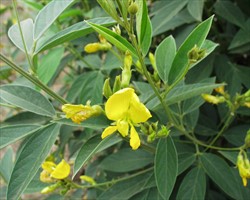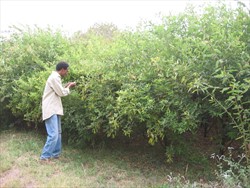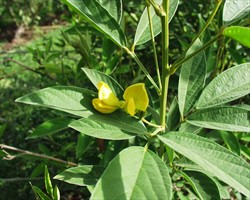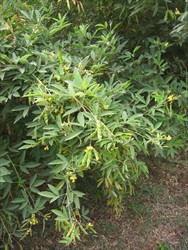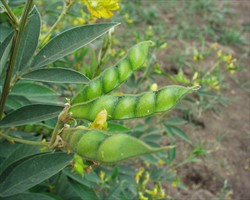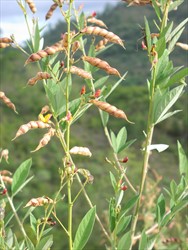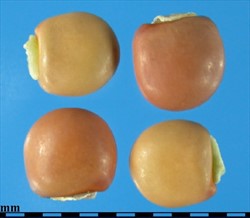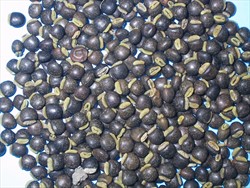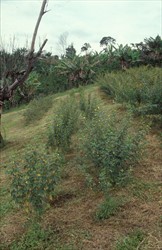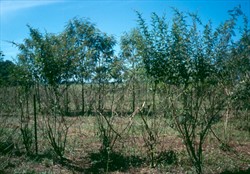Cajanus cajan
Tropical Forages
Cajanus cajan (L.) Huth
Basionym: Cytisus cajan L.; Cajanus bicolor DC.; Cajanus flavus DC.; Cajanus indicus Spreng.
Family: Fabaceae (alt. Leguminosae) subfamily: Faboideae tribe: Phaseoleae subtribe: Cajaninae.
An erect woody, annual or short-lived perennial shrub or small tree, 1–4 m tall with a deep taproot (to 2 m). Young stems are angled and pubescent. Leaves pinnately trifoliolate, alternate, set in a spiral around the stem; leaflets elliptic to lanceolate, acute, 2–10 cm long and 1.5–4 cm wide, green, velvety pubescent above, greyish-green pilose beneath, both surfaces glandular; petiole 1.0–5.5 cm long, rachis 0.8–1.3 cm long; lateral petiolules 2–3 mm long, terminal petiolule 10–20 mm; stipules linear, 2–3 mm long. Inflorescence axillary, rarely terminal panicle (pseudo-raceme), peduncle 2–7 cm long. Bracts c. 8 mm long. Flowers usually yellow, sometimes with purple or red streaks or plain red; calyx velvety pubescent and glandular, 10–12 mm long with 5 linear teeth; standard (vexillum) 1.2–1.7 cm in diameter. Pods acuminate, 4.5–10 cm long, 8–14 mm wide, 3– 4 mm thick, pubescent and glandular, containing 2–9 oval to round seeds varying in colour from light beige to dark brown. 16,000–18,000 seeds/kg.
Africa: duiwe-ertjie, Kongoboontjie (Afrikaans); jo yeri (Bambara); kassa, nwandu, wandu (Congo); waken-damfani, waken-turawa (Hausa); yergib ater, yewof ater, ohota-farengota (Ethiopia); njugu (Kikuyu); umukunde (Kinyarwanda); mpinnamiti (Luganda); nandolo, mtambe za miti, mbange, nyandolo, mbelemende, imbanga (Malawi); soso yiroo (Mandinka); salboco-ghed (Somalia); lubia adassi, ads sudani (Sudan); mbaasi, mbaazi, (Swahili); ngaghalai (Tanzania); otili (Yoruba)
Arabic: bisillah hindîyah, lûbyâ sûdânî, shakul
Asia: sândaèk dai, sândaèk klöng, sândaèk kroëb sâ (Cambodia); 木豆 mu dou, shu dou (Taiwan), huang dou shu, chieh tu, chieh tu tzu, shan tou ken (China); struikerwt, katjang goedé (Dutch, South-East Asia); arthar, kacang kacang dal, kacang hiris, kacang kayu, kacang gude, kacang Bali, kachang kayu (former spelling), kachang gude (former spelling), katjang bali (former spelling) (Indonesia); ki-mame, pijonpii, ryûkyû mame (Japan); thwàx h'ê (Laos); pe-sinngon, pay-in-chong (Myanmar); gablas, gablos, kadios, kagios, kagyos, kagyus, kaldis, kalios, kardis, kidis, kudis, tabios (Philippines); thua rae, thua maetaai, ma hae (Thailand); cay dau chieu, dau thong, đậu triều, đậu săng, đậu chiều, đậu triều, đậu thiều, đậu cọc rà (Vietnam)
Europe: ærtebønne, ærteboenne (Danish); ambrévade, pois d’Angole, pois du congo, pois cajan (French); englische Erbse, Katjangstrauch, Straucherbse, Strauchbohne, Straucherbsenbaum, Taubenerbse, Taubenerbsenbaum (German); caiano, pisello d'Angola, pisello del tropico, caiano (Italian)
English: Angola pea, cajan, catjan, cadjan pea, Congo pea, gungo pea, no-eye pea, pigeonpea, red gram, Puerto Rico pea, red gram, yellow dahl
Pacific: pi nunu, pi Pokoliko (Hawaii); pī kula (Tonga)
Indian subcontinent: অৰহৰ arahar, মিৰি মাহ mirai-maha (Assamese); অড়হর arahar (Bengali); તુવેર tuver (Gujarati); अरहर arhar, तुवर tuvar (Hindi); ತೊಗರಿ ಬೆಳೆ togari bele, ತೊಗರಿ ಕಾಳು togari kalu (Kannada); तोरी tori (Konkani); ആഢകി adhaki, തുവര tuvara (Malayalam); ꯃꯥꯏꯔꯣꯡꯕꯤ mairongbi (Manipuri); तूर tur (Marathi); रहर rahar (Nepali); ହର୍ ହର୍ har-har, କାକ୍ଷୀ kakshi, ତୁବର tubara (Oriya); आढकी adhaki, काक्षी kakshi, तुवरी tuvari (Sanskrit); ஆடகி adhaki, இருப்புலி iruppuli, காய்ச்சி kaycci, துவரை tuvarai (Tamil); khaithei (Tangkhul); ఆఢకి adhaki, కంది kandi, తొగరి togari, తువరము tuvaramu (Telugu); ارهر arhar, توأر tuar (Urdu)
Latin America: andú, cuandú, ervilha de Angola, ervilha de sete anos, ervilha do Congo, feijao andú, feijão Congo, feijão árvore, feijão de cuandú, feijão guando, guandú (Brazil); arveja de Angola, cachito, cascabellilos, chicharo de paloma, chicharo de arbol, chivatillo, frejol de palo, frejol mantecoso, fríjol de árbol, frijol de la India, frijol del monte, frijol de palo, frijol guandul, frijol quinchancho, gandul, gandules, guando, guandu, guandú, guandul, guandu quinconcho, guisante de Angola, guisante de paloma, guisante enamo, guisante gunga, guisante gungo, lenteja bocona; lenteja francesa, planta de guandú, puso-poroto, puspo poroto, quinchocho, quinchoncho, sacha poroto, timbolillo (Spanish)
Native:
Asia: India
Cultivated:
Now widespread and cultivated throughout tropics and subtropics
Forage
Foliage can be browsed but branches are brittle and inclined to break as animals pull the leaves. Foliage may also be cut and fed to livestock fresh or conserved.
Environment
Can be used as a semi-permanent, perennial component in alley cropping systems. Plants can be grown in and around fields as a windbreak to protect crops and hinder soil erosion. Dense stands act as a ground cover to reduce erosion, while open stands of taller varieties can provide shade cover for establishing plantation crops, e.g. coffee. Good nitrogen fixation makes it a useful green manure; most of fixed N is transferred to the developing seed after flowering.
Other
Primarily grown as a grain crop for seed for human consumption (pulse, vegetable) with over 4 million hectares cultivated worldwide. Stems are used for firewood. Various plant parts used in folk medicine to treat a variety of conditions.
Soil requirements
Can be grown on a wide range of soil textures, from sands to heavy black clays but needs free-drainage. Pigeon pea prefers pH of 5–7, but can tolerate pH 4.5–8.4. Genotypes vary in their tolerance of available soil aluminium and salinity. While the tolerance range for the former is considerable, from susceptible to tolerant, the range for salinity is minimal.
Moisture
As a crop, pigeonpea is very drought tolerant, able to grow with a dry season exceeding 6 months, and rainfall <300 mm, but does best with 600–1,000 mm AAR, and up to 2,500 mm providing there is unimpeded drainage. Less suited to the humid tropics with poor tolerance of wet soils or flooding.
Temperature
Pigeonpea is very tolerant of hot conditions; grows in temperatures >35 ºC when soil moisture and fertility are adequate, but generally grown in temperatures of 18–30 ºC. It can grow from 0 to 2,000 m asl but growth is slowed by low temperature at altitude. Leaf cannot tolerate frost but may escape a light ground frost due to its height.
Light
Prefers full sunlight but can tolerate some shading during the vegetative growth phase, which can result in etiolated stems. It is very sensitive to low radiation at pod development and requires full sunlight at this growth phase.
Reproductive development
Pigeon pea is typically a short day plant requiring day lengths >11.5 h for flowering. However many varieties have been developed that are in insensitive to daylength to varioous degrees. Short season varieties with lesser daylength sensitivity may start flowering only 60 days after planting while the taller woody species only flower 180–250 days after planting.
Defoliation
Leaf and young pods can be harvested and conserved, or fed fresh. Under good grazing management, perennial varieties have persisted up to 5 years. Regeneration of foliage is moderate when the plants are younger but becomes poorer as the plants become woody nearer the end of their life. Cannot tolerate frequent, severe cutting, or heavy defoliation as with continuous grazing, although regrowth occurs even when coppiced as low as 15 cm.
Fire
Very susceptible to fire.
Guidelines for establishment and management of sown forages.
Establishment
In most developing countries pigeonpea is grown as an intercrop with cereals or legumes, which are harvested to avoid competition before the pigeonpea flowers and sets seeds. Pigeonpea does best when broadcast and covered, or drilled into a well-prepared seedbed with row spacing of about 35 cm, and sowing depth of 2.5–10 cm. Sowing rates range from 0.5 to 4 kg/ha and between 5 and 7 kg/ha under irrigation. Alternatively, seeds can be placed into holes on a 2 m grid. Broadcast or planted in rows with a seed rate of over 20 kg/ha when sown as ground cover or for fodder. The plant density recommended for the later maturing highly branched fodder varieties is 50,000–60,000 plants/ha. Pigeonpea is promiscuous in it rhizobial requirements so special inoculant is not required. If inoculation is considered necessary, cowpea type strains are recommended (CB 756 in Australia, C 95 in South America). Seedlings emerge 2–3 weeks after sowing, and growth is slow until the taproot develops. The plants do not compete well with weeds in the early growth stage and it is important to keep the crop weed free in the first 6 weeks after establishment. Seedlings are difficult to transplant but it can be propagated from stem cuttings.
Fertilizer
Cajanus cajan is an efficient nitrogen-fixing species when growing conditions are favourable. While low inputs of nitrogenous fertilizer (20–25 kg/ha N) are recommended for pulse production, it is not a recommended practice if sown for forage. Phosphorus is the most limiting factor for pigeonpea and applications of 17–26 kg/ha P can increase seed yield by 300‒600 kg/ha. Most pigeonpea cultivars are susceptible to zinc deficiency. Applications of 2–4 ppm zinc as 0.5% zinc sulphate with 0.25% lime have been effective to overcome zinc deficiencies.
Compatibility (with other species)
As a forage shrub, pigeonpea can be interplanted with grasses. Tall late flowering varieties are commonly grown as a food grain crop intercropped with sorghum or millet in the semi-arid tropics. Has grown well with Chloris gayana and been planted into pangola grass (Digitaria eriantha). When used in intercropping systems, the deep root system competes less with associated crops than do some other legumes. When cultivated as a food crop it is commonly intercropped with other grain legumes such as cowpea (Vigna unguiculata ) and groundnut (Arachis hypogaea) but is not generally sown with other legumes as a forage.
Companion species
Grasses: Cenchrus americanus, Chloris gayana, Cynodon dactylon, Digitaria eriantha, Melinis minutiflora, Sorghum spp., Zea mays (intercropping).
Pests and diseases
Now grown so widely, there are numerous pests and diseases that inflict damage on the crop at vegetative and reproductive stages, the range varying from country to country. Some of the more common insect pests are the pod borer (Helicoverpa armigera), legume pod borer (Maruca testulalis), pod fly (Melanagromyza spp.), blister beetle (Mylabris spp.), pod bug (Clavigralla spp.), plume moth (Exelastis atomosa) and blue butterfly (Lampides boeticus). Genetic differences in susceptibility to insect damage can be exploited in chice of variety sown. Seeds are relatively soft and attacked by bruchid weevils during storage.
Pigeonpeas are susceptible to Fusarium wilt especially on wet soils. They are also infected by numerous other fungal, viral and bacterial diseases of leaf and stem, as well as by a range of soil nematodes. Despite the large list of potential biological problems, pigeon peas are successfully grown across many countries, in areas where other pulses may not thrive.
Ability to spread
No information available.
Weed potential
No record of weediness found.
Nutritive value
High quality leaf (10–18% crude protein), especially when developing seed pods are mixed with the edible stem fraction. Recent work on leaf fed to sheep in India indicated that older leaves have a higher nutritional value and sheep fed on young foliage did not gain weight as expected. However, threshing waste was an extremely nutritious feed for sheep.
Palatability/acceptability
Moderately unpalatable until stock become accustomed to the taste. Palatability increases with age of the plant and it has been reported that grazing should start at the podding stage.
Toxicity
No toxicity has been reported.
Feedipedia link
Dry matter
In semi-arid conditions in the drylands of Africa, fodder yield is usually in the order of 2 t/ha. However, DM yields may be up to 25 t/ha and may reach up to 40 t/ha with 100 kg/ha N under optimal conditions. Leaves remain on the plant under dry conditions. Good yields of wood for fuel although calorific value is low. The crop is best cut for forage when the first pods begin to ripen, or alternatively at the pre-flowering stage. To obtain good regrowth, plants should be cut high, at 50–75 cm in taller varieties, allowing them to regrow to 150 cm before the next harvest. Commensurately lower cutting heights should be adopted for lower-growing types. As with many other weakly perennial leguminous shrubs, excessively low cutting can kill the plant.
Animal production
Cattle on pigeonpea pasture gained 0.7–1.25 kg/day at carrying capacity of 1–3.75 cattle/ha, with liveweight gains of 200–500 kg/ha/yr in Brazil.
Mostly diploid (2n = 22), rarely tetraploid (2n = 44) or hexaploid (2n = 66).
Natural outcrossing varies from 5 to 70 per cent depending on prevailing weather conditions (temperature, humidity, wind velocity and direction), insect pollinators (usually honeybees) and their location in relation to crop field and flower morphology of genotypes. Pigeonpea has a variety of genetic mechanisms, including protogyny, male sterility and weak self-incompatibility, to promote natural out-crossing.
Susceptibility to fusarium wilt and sterility mosaic disease (SMD) have limited the utilisation of pigeonpea as a perennial species. Genotypes combining resistance to both diseases have now been bred that should improve perenniality of Cajanus cajan in forage or agroforestry systems.
Minimum soil fertility levels of about 56 kg N, 5 kg P, and 22 kg K are required to produce 1 tonne of seeds. Normally the crop is harvested by cutting the stems and stacking them to dry, before beating to release the pods and seeds. Cutting at above 15 cm height allows regrowth for a second crop. Seeds may also be harvested by hand picking, taking care not to cause much defoliation so as not to reduce flowering and podding and promote a second crop. Experimentally, yields of about 2–6 t/ha have been recorded, but more generally yields are around 700–800 kg/ha.
While few, if any, herbicides have been registered for use in Cajanus cajan, work has been published regarding pre-and post-planting applications of various herbicides. Pre-plant incorporation of fluchloralin, pre-emergence applications of pendimethalin, alachlor and linuron, and post-emergence applications of clodinafop-propargyl, quizalofop, and imazethapyr have been found to have minimal or no effect on the legume. However, if pigeonpea is being sown with a grain or forage grass, care should be taken to ensure that any chemicals used do not have adverse effects on the grass.
- Very drought tolerant.
- Dual purpose crop for grain and fodder.
- Tolerates low fertility soils.
- Excellent green manure for improving soil structure and quality.
- Short life as annual or weak perennial.
- Grazing cattle break brittle branches.
- Not very palatable.
- Not tolerant of frost nor waterlogged conditions.
- Susceptible to insects and diseases.
Ayenan, M.A.T., Ofori, K., Ahoton, L.E. and Danquah, A. (2017) Pigeonpea [(Cajanus cajan (L.) Millsp.)] production systems, farmers' preferred traits and implications for variety development and introduction in Benin. Agriculture & Food Security 6:48. doi.org/10.1186/s40066-017-0129-1
Duke, J.A. (1981) Handbook of legumes of world economic importance. Springer, Boston, USA. p. 33–37. doi.org/10.1007/978-1-4684-8151-8
Guedes, R. and Araujo, F.P. (2010) Forage production for smallholder farmers in the semi-arid region of Brazil. Proceedings of the 19th World Congress of Soil Science: Soil Solutions for a Changing World, 1–6th August 2010, Brisbane, Australia. p. 175–178. bit.ly/3bsoSK6
Nene, Y.L., Hall, S.D. and Sheila, V.K. (eds). (1990) The Pigeonpea. CAB International, Wallingford, Oxon, UK.
Rao, S.C., Phillips, W.A., Mayeux, H.S. and Phatak, S.C. (2003) Potential grain and forage production of early maturing pigeonpea in the southern Great Plains. Crop Science 43:2212–2217. doi.org/10.2135/cropsci2003.2212
Shenkute, B., Hassen, A., Ebro, A. and Amen, N. (2013) Performance of Arsi-Bale kids supplemented with graded levels of pigeonpea in dry seasonin Mid Rift valley of Ethiopia. African Journal of Agricultural Research 8:2366–2370. doi.org/10.5897/AJAR11.1533
Most breeding and selection work on Cajanus cajan has been carried out with respect to grain production. Consequently, it is difficult to find references to accessions that have been specifically selected as forage or multipurpose varieties. However, there is such wide variation in genetic material available around the tropics, that selection of niche genotypes should be feasible providing edaphic and climatic conditions are suitable.
ILRI 16555 Selected in Ethiopia and Nigeria. Tall late flowering bushy perennial, well adapted to acid red low fertility soils.
